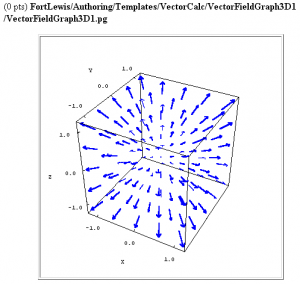VectorFieldGraph3D1
Graphing a Vector Field in Space
This PG code shows how to make an interactive graph of a vector field displayed with the LiveGraphics3D Java applet.
- Download file: File:VectorFieldGraph3D1.txt (change the file extension from txt to pg when you save it)
- File location in NPL:
FortLewis/Authoring/Templates/VectorCalc/VectorFieldGraph3D1/VectorFieldGraph3D1.pg
| PG problem file | Explanation |
|---|---|
|
Problem tagging: |
|
DOCUMENT(); loadMacros( "PGstandard.pl", "MathObjects.pl", "parserVectorUtils.pl", "PGcourse.pl", "LiveGraphicsVectorField3D.pl", ); TEXT(beginproblem()); |
Initialization:
We need to include the macros file |
Context("Numeric");
Context()->variables->are(x=>"Real",y=>"Real",z=>"Real");
$plot = VectorField3D(
Fx => Formula("x"),
Fy => Formula("y"),
Fz => Formula("z"),
xvar => 'x',
yvar => 'y',
zvar => 'z',
xmin => -1,
xmax => 1,
ymin => -1,
ymax => 1,
zmin => -1,
zmax => 1,
xsamples => 4,
ysamples => 4,
zsamples => 4,
axesframed => 1,
xaxislabel => "X",
yaxislabel => "Y",
zaxislabel => "Z",
vectorcolor => "RGBColor[0.0,0.0,1.0]",
vectorscale => 0.2,
vectorthickness => 0.01,
outputtype => 4,
);
|
Setup:
The
Setting |
Context()->texStrings;
BEGIN_TEXT
$BCENTER
\{
Live3Ddata(
$plot,
image => "exploding-vector-field.png",
size => [400,400],
tex_size => 600,
tex_center => 1,
scale => 1.25,
);
\}
$ECENTER
END_TEXT
Context()->normalStrings;
|
Main Text:
To display the string of plot data
After you construct the vector field you like, don't forget to take a screen shot of it and make an image file such as |
$showPartialCorrectAnswers = 1; |
Answer Evaluation: |
Context()->texStrings;
BEGIN_SOLUTION
${PAR}SOLUTION:${PAR}
Solution explanation goes here.
END_SOLUTION
Context()->normalStrings;
COMMENT('MathObject version.');
ENDDOCUMENT();
|
Solution: |
